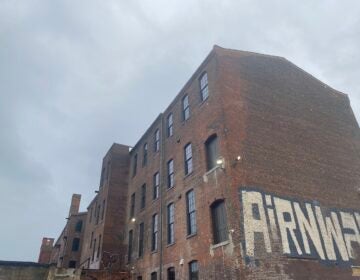Design review: antidote or added burden?

By Matt Blanchard
For PlanPhilly
What if a major new apartment house promises to be an asset to the community, providing jobs and shops and homes – but it’s a painful shade of pink?
What if a new office building meets all the regulations for height, density, and parking – but its design is tacky enough to be tragic?
Cities like Baltimore, Boston, Atlanta, Pittsburgh and Phoenix have answered these questions by establishing “design review boards,” appointed committees of architects, planners, artists and builders empowered to intercept chintzy and charmless projects before they do damage to the skyline.
A far cry from the “picket fence police” of suburban homeowners’ associations, most design review boards are advisory bodies, providing useful suggestions on how to humanize big projects. But other boards have unfettered veto power over plans they don’t like; Baltimore recently sent a major developer back to the drawing board because his $80 million mixed-use project was “too dark and simple.”
Philadelphia has no such board, but it may soon.
With a new mayor on the way and a new Zoning Code Commission hard at work, the city’s fragmented method for dealing with development is slated for major reform. Design review boards came up at Thursday’s ZCC meeting, and at the recent “Planning Roundtables” hosted by the Planning Commission.
Among those pushing for a Philadelphia design review board is architect Alan Greenberger, chair of the Design Advocacy Group.
“Cities that have taken design seriously also happen to be the cities that are doing very well. It creates an attraction for people to move there, to enjoy living there,” Greenberger says. “You read about Boston’s design review board, and you think ‘Oh yeah. We’re really not doing this right.’”
Philadelphia Today
According to a study by the Delaware Valley Regional Planning Commission, what little design review does happen in Philadelphia is fragmented and incomplete. The Art Commission handles projects built on city land or with city money. The Historical Commission reviews only those projects affecting structures on the city’s historic register. The Fairmount Park Commission, PIDC and the RDA each have some type of review, and neighborhoods like Society Hill issue their own design guidelines they expect builders to follow.
But for the vast majority of projects, Philadelphia’s only bulwark against bad design is the Zoning Board of Adjustment, whose members, it is often said, are neither professionally qualified or legally entitled to judge aesthetics.
“The ZBA has inherited [design review] over the years because no one else has done it,” ZBA president David Auspitz said on Thursday. “And quite frankly, there should be someone who’s in charge of doing it.”
Fixing the system is tricky, however. Auspitz and others warn against adding yet another layer of bureaucracy – and yet another month-long delay – to the city’s permitting process.
“I don’t want to keep sending people to more and more boards and commissions,” he said. “I want to get them out there building!”
Auspitz opposes a design review board, suggesting much of the task can instead be handled more efficiently by Planning Commission staff.
Creating a design review board for Philadelphia also carries unanswered questions: Would it have the power to approve, or merely advise? Would it report to the Mayor? City Planning? The ZBA? Or would it be an independent power immune to political pressure?
If Philadelphia does decide to opt for design review, here are two different models, as described by a recent study by Greg Heller of DVRPC.
The Baltimore Model – Approval Power
Created in 1964 and periodically modified, Baltimore’s Urban Design and Architecture Review Panel (UDARP) occupies the powerful end of the spectrum. The board is politically sovereign, and without their approval, a project cannot move forward.
UDARP is a six-member panel of experts in architect, planning and landscape design, appointed by the city’s director of planning. Political outsiders are said to be preferred.
UDARP reviews a broad array of public and private projects sent their way by the planning commission. Their scrutiny of a project can be quite intense, potentially including everything from the site plan to the nature of the pedestrian realm, to green building technologies, historic context, materials, color palette and even the plants in the lawn.
Yet the panel appears to have public support, and coverage of their proceedings in newspapers undoubtedly elicits heightened public involvement in design decisions that escape notice here in Philadelphia.
At the recent ZCC meeting, Philadelphia architect Emmanuel Kelly said he’s worked with Baltimore’s UDARP. Despite its intense scrutiny, Kelly said the panel does not unduly slow development.
“Integration is the key,” Kelly said. “It works smoothly because it is integrated into the development appeals process. It’s not cumbersome.”
The Boston Model – Advisory Power
Boston’s Civic Design Commission (BCDC) is itself an advisory body, but its advice goes straight to the powerful Boston Redevelopment Authority, a centralized entity equivalent to Philadelphia’s RDA, Planning Commission and several other agencies combined.
The BCDC is just one step in Boston’s rigorous development approval process, and unlike our wide-ranging ZBA, it avoids local political concerns and focuses narrowly on design.
The commission consists of 11 design professionals appointed by the mayor, empowered to review all projects over 100,000 square feet. Massing, materials and visual impact of a project are all considered, but the commission has a 60-day window in which to render a judgment.
Philadelphia’s Alan Greenberger favors Boston’s advisory model over because it allows for an open-ended encounter between builders and the community, guided by top-notch designers on the commission itself.
“You want to create such a credible operation, thoughtful, substantive, stocked with people who have such clear expertise, that their recommendations are taken very seriously,” Greenberger said.
In fact, Greenberger is already pioneering this model here in Philadelphia. With fellow DAG members, he’s performed design reviews for major housing projects along the Delaware River in Tacony and in Old City.
The challenge to any advisory model in Philadelphia is who, precisely, would the panel advise; the Planning Commission is itself an advisory body to the City Council. What’s more, the recent referendum calling for professional architects to be added to the Planning Commission may well be seen to obviate the need for a special design review team.
Even so, Greenberger says the current patchwork system of design review is untenable.
“Sometimes I think maybe this crazy system is okay,” he said. “But really it’s not okay. It’s a sort of sickness we all learned to live with… And I’ve talked to a number of developers who won’t develop in Philadelphia because it’s nuts. Our kind of craziness puts out a message that the city does not have its act together.”
Auspitz disagrees entirely, seeing no need for a design review board.
“We need to figure out a process without adding another 3 months of delay,” the ZBA chair said. “Most of [our system] works very, very well, especially under the new planning commissioner Janice [Woodcock]. If you have a project, they’ll chat with you. It’s a user-friendly situation.”
.
WHYY is your source for fact-based, in-depth journalism and information. As a nonprofit organization, we rely on financial support from readers like you. Please give today.






